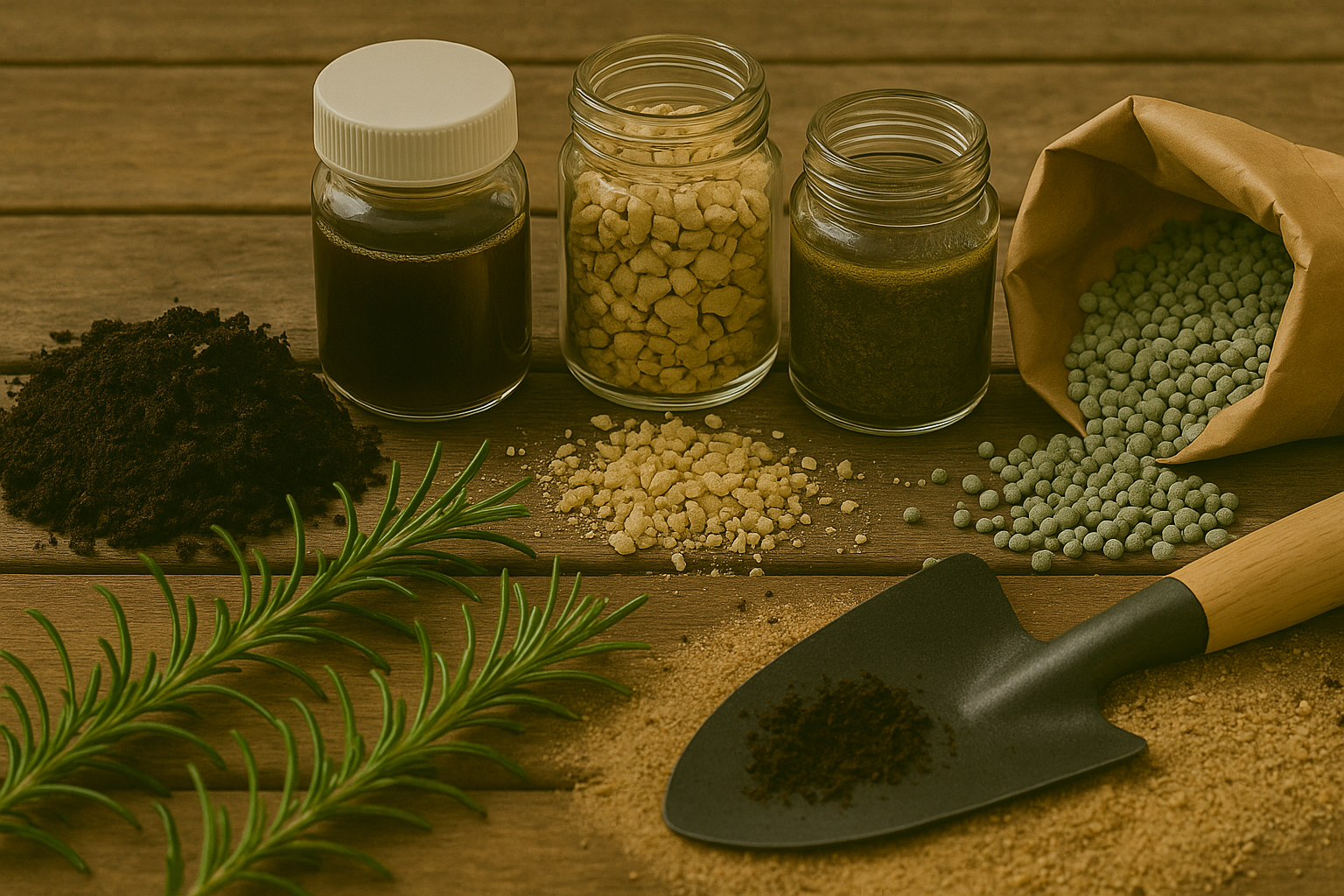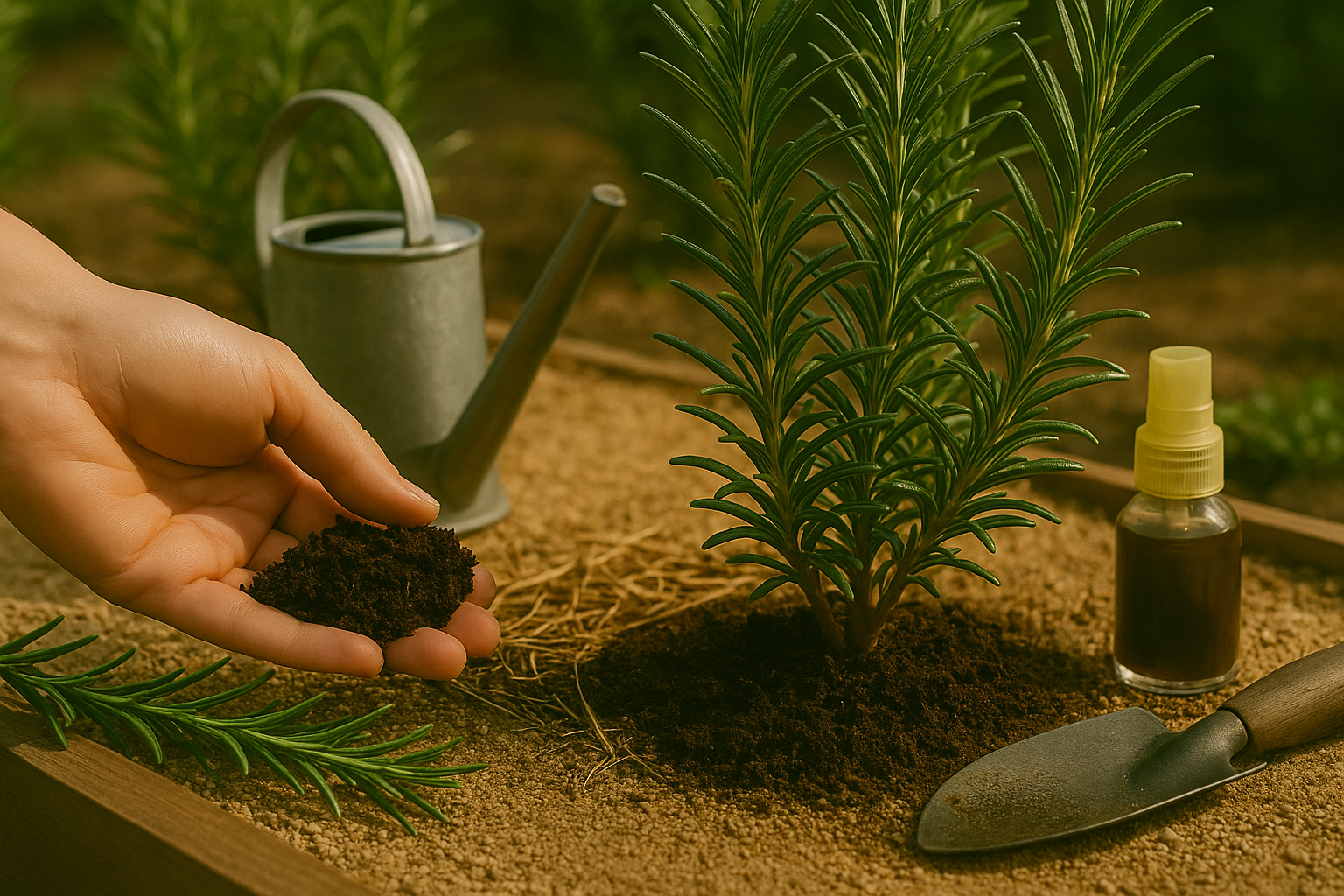Understanding Rosemary’s Fertilizer Needs

Rosemary is native to the dry, rocky hillsides of the Mediterranean, where soils are naturally low in nutrients and drain quickly. This background means rosemary thrives with minimal fuss and doesn’t need rich, heavily amended soil to grow well—making it a great choice for those wanting a low-maintenance addition to their gardens.
In fact, over-fertilizing is a common mistake: it can cause rosemary to grow leggy, lose its intense flavor, or even become more prone to diseases. Instead, think of fertilizing as a light touch rather than a routine chore—feeding once in spring with a balanced, all-purpose fertilizer is usually enough to support healthy growth, especially if your rosemary is in a container and nutrients deplete faster.
For those curious about fertilizer types:
- Organic options like compost or well-rotted manure enrich the soil gently and improve its structure over time, mimicking rosemary’s natural environment.
- Store-bought synthetic fertilizers offer quick results and are easy to measure, but they’re best applied sparingly to avoid overwhelming the plant.
No matter which you choose, remember rosemary’s roots prefer a lean diet and good drainage; sometimes a little less is truly more. Regular observation is key—if your rosemary looks pale or isn’t thriving, a light feeding can help, but if it’s lush and fragrant, your hands-off approach is just right.
Preparing Your Soil
Getting your soil right is the first step to growing healthy, robust rosemary. This Mediterranean herb thrives in well-draining soil, ideally with a slightly sandy texture and a neutral to slightly alkaline pH of 6.5 to 7.5. Dense or clay-heavy soils hold too much moisture and can quickly lead to root rot. If your garden soil tends to stay wet after rain, mix in generous amounts of coarse sand or fine gravel to improve drainage.
Amending the soil before planting means your rosemary won’t need much extra fertilizer later. Natural soil boosters like homemade compost, aged manure, or worm castings gradually release nutrients, promoting strong root growth and reducing the risk of nutrient overload.
For a garden bed, remove weeds and loosen the soil to at least a foot deep, then blend in a couple of inches of organic matter until evenly mixed. If you’re planting in containers, choose a high-quality potting mix labeled for Mediterranean herbs or make your own by blending equal parts potting soil, coarse sand, and compost. Make sure containers have drainage holes—rosemary hates soggy roots.
Before transplanting, water the soil and let the excess drain out; this primes the ground for young plants. Even with minimal soil prep, you’ll set your rosemary up for a hearty, disease-resistant future—and spend less time fixing problems later. Taking these extra few steps at the start makes all the difference for a thriving, aromatic herb garden.
Organic Fertilizer Options for Rosemary

When growing rosemary, choosing the right organic fertilizer can make a noticeable difference in plant vigor, flavor, and resilience. Rosemary thrives with a well-balanced but moderate nutrient supply—its ideal N-P-K (nitrogen-phosphorus-potassium) ratios are generally around 4-3-3 or 5-5-5, avoiding excessive nitrogen that can cause soft, leggy growth instead of sturdy, aromatic foliage.
Compost is a user-friendly favorite, offering a gentle nutrient release plus improved soil texture and beneficial microbes. Top-dress your rosemary with a 1-inch layer of finished compost every spring and again mid-summer.
Fish emulsion provides a quick shot of nitrogen (N ranges between 4 and 6), which can give rosemary a boost in early spring, but use it sparingly—dilute as recommended on the label and feed only every four to six weeks.
Seaweed extract is low in N-P-K (typically around 0.2-0.3-2), but it’s prized for its micronutrients and ability to help rosemary withstand drought or heat stress. Foliar spray every four to six weeks works well, especially during mid-season heat waves.
Bone meal offers long-lasting phosphorus and some calcium (with N-P-K ratios like 3-15-0), supporting root development and flowering. It’s most useful when starting new rosemary plants or transplanting—mix it into the planting hole or sprinkle on the soil in early spring.
Each option has its strengths:
- Compost and seaweed are highly sustainable with minimal environmental impact.
- Fish emulsion and bone meal, though natural, rely on animal sources.
Over-applying any fertilizer, even organic, can lead to nutrient imbalances, so apply moderately and monitor growth.
For best results, create a seasonal routine: compost in early spring, a touch of fish emulsion after pruning, seaweed spray during hot spells, and bone meal when planting or once a year. This balanced approach supports strong, healthy rosemary plants and minimizes environmental footprint, while the variety of organic options lets you tailor feeding to your garden’s specific needs.
Store-Bought (Synthetic) Fertilizers
Store-bought or synthetic fertilizers are a popular choice for boosting herb growth because of their convenience and predictable results. You’ll find a range of products on shelves, from all-purpose blends to herb-specific formulas.
For rosemary, a woody Mediterranean herb, look for fertilizers with a balanced or slightly lower nitrogen (N) number, such as 5-10-10 or 4-4-6 on the N-P-K label (which stands for nitrogen, phosphorus, and potassium). Too much nitrogen can promote weak, leggy growth and lessen rosemary’s signature fragrance, so avoid high-N lawn or vegetable mixes.
When applying fertilizer, always read the package instructions closely and consider diluting liquid feeds to half the recommended strength—rosemary thrives in leaner soils and is more sensitive to overfeeding than many garden plants. Space feedings at least four to six weeks apart during the active growing season (spring through midsummer), and never fertilize in winter when the plant is dormant.
Sprinkle granular fertilizer lightly around the root zone but not directly against the stem, and water well afterward to help the roots absorb nutrients without risk of burn. Over-fertilizing can cause salt buildup, yellowing leaves, or drooping stems, so if in doubt, err on the side of underfeeding and watch how your rosemary responds before adding more.
Remember, a healthy, flavorful rosemary plant benefits more from steady, modest nutrients than heavy-handed doses.
Fertilizing Rosemary in Containers vs. Garden Beds
Rosemary is a hardy herb, but its fertilization needs vary depending on whether it’s grown in containers or garden beds. Potted rosemary requires more frequent attention since nutrients in containers wash out quickly with regular watering. In contrast, garden beds with rich soil retain nutrients longer, so outdoor rosemary may only need light feeding once or twice during the growing season.
For containers, use a balanced, water-soluble fertilizer—either organic, like fish emulsion or seaweed extract, or a diluted synthetic blend—monthly during active growth. Avoid over-fertilizing, as too much can encourage leggy growth and reduce essential oil concentration. Always water your potted rosemary before fertilizing to protect the roots and minimize the chance of fertilizer burn.
Ensure pots have excellent drainage by using a well-draining soil mix and unblocked drainage holes, since rosemary hates “wet feet.” In garden beds, an annual handful of compost often suffices. If you do use fertilizer in beds, choose slow-release types or organic amendments mixed into the soil in early spring.
Regardless of where you grow rosemary, consistent but not overly frequent watering is key. Allow the soil to dry slightly between waterings, especially in pots, where soggy conditions can quickly lead to root rot. By paying attention to the specific needs of rosemary in containers versus beds—and tailoring your fertilization, watering, and soil approach—you’ll cultivate healthy, flavorful herbs with minimal risk of damage.
Identifying Deficiency and Avoiding Common Mistakes
Noticing signs like yellowing leaves, stunted growth, or sudden leaf drop often signals that your plants may be suffering from a nutrient deficiency. For example, yellow leaves can indicate a lack of nitrogen or iron, while purplish discoloration sometimes means there isn’t enough phosphorus. Stunted growth or fewer flowers and fruits are clues that your plant isn’t getting what it needs to thrive.
A common mistake many gardeners make is over-fertilizing, thinking more nutrients will lead to better growth. In reality, this can burn roots and cause toxic buildup, making leaves brown or wilt. On the other hand, under-fertilizing—skipping feedings or using too little fertilizer—starves plants, leaving them pale and weak.
Timing also matters: fertilizing at the wrong time, like during dormancy or midday heat, can stress or shock plants. To correct these problems, always read and follow fertilizer package directions, using only the recommended amounts. Test your soil to pinpoint deficiencies before adding amendments. If you think you’ve over-fertilized, flush the soil with plenty of water to remove excess nutrients.
For a quick boost, use a balanced, water-soluble fertilizer applied when plants are actively growing and not under stress. Pay attention to plant-specific needs—what tomatoes want may differ greatly from what orchids require.
By regularly observing your plants and learning their cues, you’ll become better at spotting deficiencies early and providing corrective care before bigger problems develop.
Seasonal Fertilizing Tips and Maintenance
For thriving rosemary plants, adopt a seasonal fertilizing schedule to support growth and resilience. In early spring, when rosemary emerges from winter dormancy, apply a balanced, slow-release fertilizer or compost to give it a healthy kickstart. Use a light touch to prevent over-fertilization, which rosemary dislikes.
As summer arrives, top up with diluted liquid fertilizer every four to six weeks—this is especially helpful if rosemary is in pots, since containers leach nutrients faster than in-ground beds. Avoid feeding late in the fall, since new tender growth is vulnerable to frost and rosemary prefers to harden off for winter.
If you’re gardening in a hot, dry climate, cut back on the frequency and strength of feedings, as too much nutrition during heat stress can overwhelm the plant. For cooler regions or damp climates, use sandy, well-draining soil mixes and hold off on heavy fertilizing, since excess moisture combined with fertilizer can invite root rot.
Adjust routines for plant maturity—young rosemary benefits from more consistent, milder feedings, while established shrubs thrive with minimal intervention once or twice per year. To maximize long-term health and harvest:
- Prune after flowering to encourage bushy growth.
- Mulch beds with gravel to improve airflow.
- Rotate pot locations to maximize sun exposure.
- Regularly snip sprigs—frequent light harvesting actually makes plants fuller over time.
Most importantly, always water before fertilizing, as dry roots are sensitive. These simple habits keep rosemary robust, aromatic, and ready for your kitchen year-round.
